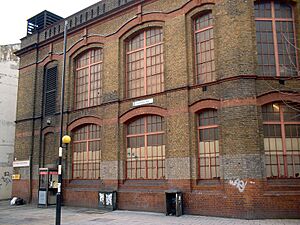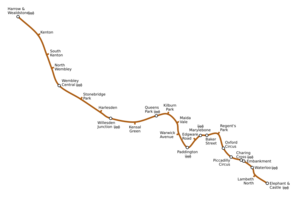Bakerloo line facts for kids
Quick facts for kids Bakerloo line |
|
|---|---|

A 1972 Stock Bakerloo Line train at Queen's Park
|
|
| Overview | |
| Stations | 25 |
| Colour on map | Brown |
| Website | tfl.gov.uk |
| Service | |
| Type | Rapid transit |
| System | London Underground |
| Depot(s) | Stonebridge Park London Road Queen's Park |
| Rolling stock | 1972 Tube Stock |
| Ridership | 111,136,000 (2011/12) passenger journeys |
| History | |
| Opened | 10 March 1906 |
| Technical | |
| Line length | 23.2 km (14.4 mi) |
| Character | Deep level |
| Track gauge | 4 ft 8 1⁄2 in (1,435 mm) |
The Bakerloo line is a train line that is part of the London Underground system. You can easily spot it on the Tube map because it's coloured brown. This line runs both above ground and deep underground. It stretches from Elephant & Castle in south-east London all the way to Wealdstone in the north-west.
The Bakerloo line has 25 stations in total. Out of these, 15 are located deep underground. The entire line is about 23.2 kilometres (14.4 miles) long. The line got its unique name by combining parts of two important stations it serves: Baker Street and Waterloo. North of Queens Park, the Bakerloo line runs right next to the West Coast Main Line, which is a major railway route.
Contents
Exploring Bakerloo Line Stations

The Bakerloo line connects many different parts of London. Here's a list of the stations it serves, from north to south. Some stations have interesting facts about when they opened or if their names changed.
Note: If you want to learn about the former Stanmore branch of the Bakerloo line, check out the Jubilee line article.
| Station | Image | Opened | Quick Facts |
|---|---|---|---|
| Harrow & Wealdstone |
16 April 1917 | Closed briefly in 1982, reopened in 1984. | |
| Kenton | 16 April 1917 | Closed briefly in 1982, reopened in 1984. | |
| South Kenton | 3 July 1933 | Closed briefly in 1982, reopened in 1984. | |
| North Wembley | 16 April 1917 | Closed briefly in 1982, reopened in 1984. | |
| Wembley Central |  |
16 April 1917 | First called Wembley Central for Sudbury. Renamed in 1948. Closed briefly in 1982, reopened in 1984. |
| Stonebridge park | 1 August 1917 | ||
| Harlesden | 16 April 1917 | ||
| Willesden Junction | 10 May 1915 | ||
| Kensal Green | 1 October 1916 | ||
| Queen's Park | 11 February 1915 | ||
| Kilburn Park | 31 January 1915 | ||
| Maida Vale | 6 June 1915 | ||
| Warwick Avenue | 31 January 1915 | ||
| Paddington (Trains to Heathrow) |
1 December 1913 | ||
| Edgware Road |  |
15 June 1907 | |
| Marylebone | 27 March 1907 | First called Great Central. Renamed in 1917. | |
| Baker Street | 10 March 1906 | ||
| Regent's Park |  |
10 March 1906 | |
| Oxford Circus |  |
10 March 1906 | |
| Piccadilly Circus | 10 March 1906 | ||
| Charing Cross |  |
10 March 1906 | |
| Embankment | 10 March 1906 | ||
| Waterloo | 10 March 1906 | ||
| Lambeth North | 10 March 1906 | Had two previous names: Kennington Road and Westminster Bridge Road, before becoming Lambeth North in 1917. | |
| Elephant & Castle |  |
5 August 1906 |
Future Plans: Extension to Camberwell
There have been talks about extending the Bakerloo Line further south to Camberwell. This idea first came up in the late 1940s but was cancelled. More recently, in the 21st century, the plan was brought up again. So far, no final decision has been made. The original 1940s plan included two new stations. One reason it might have been cancelled back then was that Camberwell was not seen as a good place for further extensions.
Bakerloo Line's Past: Former Stations
The Bakerloo line used to serve more stations than it does today. Over the years, some parts of the line were changed or transferred to other train services.
Watford Branch
Between 1917 and 1982, Bakerloo line trains went beyond Harrow & Wealdstone all the way to Watford Junction. These stations are now served by the London Overground trains.
| Station | Opened | Closed | Notes |
|---|---|---|---|
| Watford Junction | 16 April 1917 | 16 September 1982 | |
| Watford High Street | 16 April 1917 | 24 September 1982 | |
| Bushey & Oxhey | 16 April 1917 | 24 September 1982 | Renamed Bushey in 1974. |
| Carpenders Park | 5 April 1919 | 24 September 1982 | Closed and reopened on a new site in 1952. |
| Pinner & Hatch End | 16 April 1917 | 24 September 1982 | Renamed Hatch End (for Pinner) in 1920, then Hatch End in 1956. |
| Headstone Lane | 16 April 1917 | 24 September 1982 |
Stanmore Branch
The Stanmore branch was originally built by the Metropolitan Railway (which is now the Metropolitan line). It became part of the Bakerloo line in 1939. Later, on May 1, 1979, this branch was transferred to the Jubilee line. It connected to the main Bakerloo line at Baker Street.
Here are the stations that were once part of the Bakerloo line's Stanmore branch:
- Stanmore
- Canons Park
- Queensbury
- Kingsbury
- Wembley Park
- Neasden
- Dollis Hill
- Willesden Green
- Kilburn
- West Hampstead
- Finchley Road
- Swiss Cottage
- St. John's Wood
Bakerloo Line Map
You can find an official diagram of the Bakerloo line online from Transport for London (TFL) here: TFL line diagram.
Images for kids
See also
 In Spanish: Bakerloo Line para niños
In Spanish: Bakerloo Line para niños






